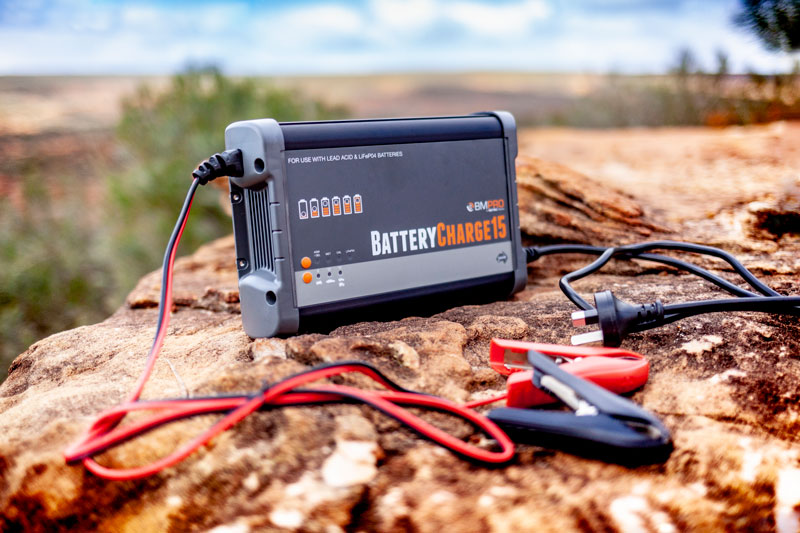Lithium battery chargers
This post has been originally published in May 2019 and has been updated in September 2021.
When we wrote this blog post initially, lithium batteries for caravans were the way of the future. Today, they are the battery of choice for many adventurers. However, the question stays:
Do you need a lithium battery charger to charge your battery?
Lithium batteries have grabbed the attention of the RV market in recent years. Their power-to-weight ratio is much better than equivalent lead acid / deep-cycle / AGM / Gel Cell batteries, and they have a higher discharge rate than those batteries as well. But, given that lithium iron phosphate (LiFePO4) batteries have very different characteristics and composition to other batteries, it raises the question as to whether they require different battery chargers. To answer that, it helps to have an understanding of how lithium batteries function.
HOW DO LITHIUM BATTERIES WORK?
One of the major advantages of lithium batteries is that they can deliver a very large current down to about 20% of their capacity without any damage, and with 3% or less voltage drop. That might not sound impressive until you compare it with a deep-cycle/AGM battery. The most effective way of getting a good battery life out of those batteries is to never let them discharge below 50% capacity. Doing that, a typical lifespan of about 500 – 600 charge/discharge cycles can be expected.
However, a LiFePO4 battery will deliver well over 2000 cycles, as shown in a real life experiment held at the BMPRO headquarters. And whilst lithium batteries will only have a 3% voltage drop for much of the discharge cycle, all deep cycle/AGM batteries suffer from a constant voltage drop whilst discharging; the typical range being 12.75-11.4 volts.
Like most battery types, lithium batteries have individual cells (four, in this case), which are rated at 3.2V each for a total output of 12.8V. The problem is that once an individual cell is charged, it turns off the current and, since all the cells are wired in series, they then cease charging. For this reason, any LiFePO4 battery should have its own inbuilt management system to ensure that all cells are charged equally.
HOW DO LITHIUM BATTERIES CHARGE?
So does all that change the way a lithium battery should be charged? And what does the charging profile of a LiFePO4 battery look like?
Battery charging profile
A charging profile is a reference to the way voltage and current vary during a full charge of a battery, and it does differ depending on the type of battery, because they are functionally dissimilar and constructed in different ways. For example, a fully charged lead acid battery will have a voltage of around 12.6-12.7V, whereas a LiFePO4 battery has voltage around 13.3-13.4V at full charge. At 20% capacity, a lead acid battery will have a voltage around 11.8V, whereas a lithium battery will hold its voltage at approximately 13V.
Without getting too technical, the LiFePO4 battery has a much smaller voltage tolerance and, because of that, the ‘trickle’ charge of the deep-cycle battery does not apply. And that means a LiFePO4 battery can be charged faster while minimising the risk of overcharging.
Constant voltage, constant current or a trickle charge?
In discharge cycle, or when powering a load, a chemical reaction takes place that causes electrons to flow between the positive and negative electrodes via the battery electrolyte. A charger reverses that chemical reaction, thus, recharging the battery. A typical charging voltage for a 12V battery varies between 12.9V and 14.1V. While a constant voltage and current will charge a battery quickly, it’s considerably better for a deep-cycle battery’s health if a ‘trickle’ charge is used over a longer period of time. Multi-stage chargers are considered best for this purpose.
LiFePO4 batteries operate a little differently but an appropriate charge is also best for maximum battery life. Generally speaking, a constant current (only really restricted by the charger output) will flow until the battery reaches 90-95% of its state of charge (SOC). Once that point is reached, the current will reduce, while the voltage will do the opposite, rising to a cut off voltage of a theoretical 16.8V (but in reality is usually around 14.7V).
DO I NEED A LITHIUM BATTERY CHARGER TO CHARGE MY LITHIUM BATTERY?
The bottom line is that not all chargers are created equal and you need to ensure your charger, or the one you’re considering buying, such as BMPRO’s BatteryCharge range (from 4-25 Amp), includes a lithium charging profile.
Dedicated Lithium battery chargers will help ensure you maintain an economical battery life and get the best out of your lithium battery.
To learn more about lithium battery chargers, check our YouTube channel and visit BMPRO Lithium Battery Knowledge Centre.
Like this Post? Share it!






